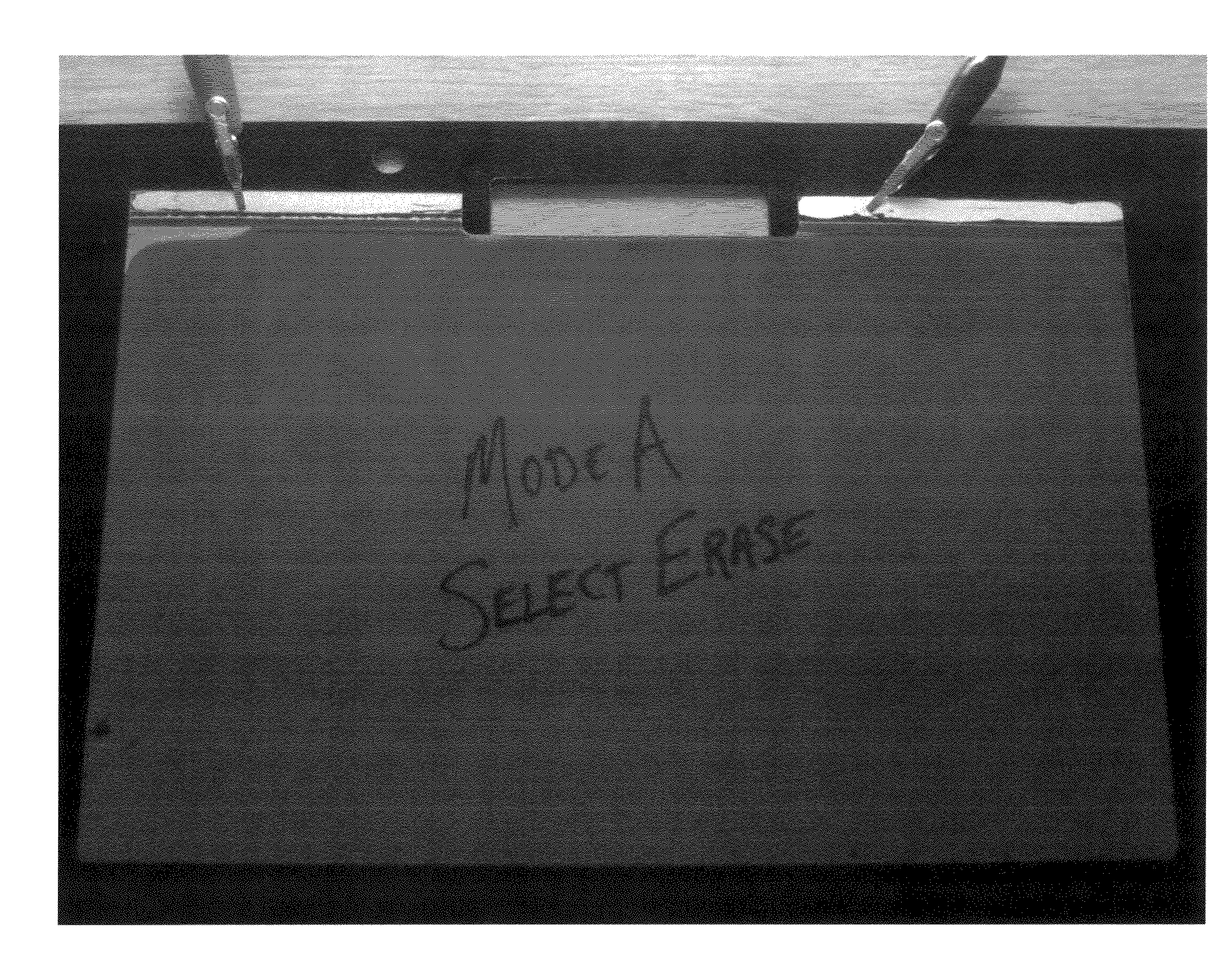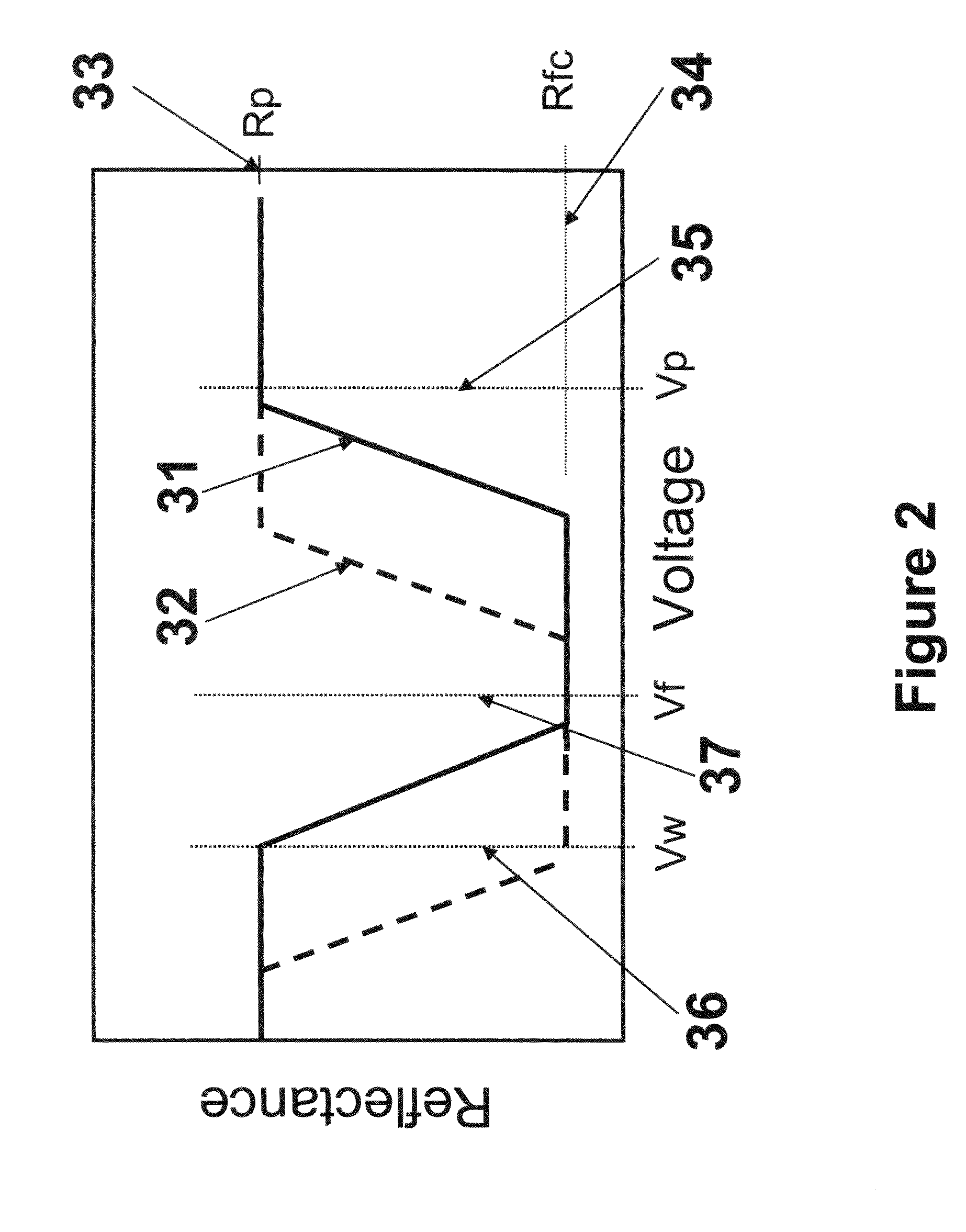Selectively erasable electronic writing tablet
a technology of electronic writing and eraser, which is applied in the direction of writing boards, instruments, printing, etc., can solve the problems of consuming a lot of power, slow and inconvenient heat or flexing of the device to erase the image, and erasing the image, and achieve the effect of low device cos
- Summary
- Abstract
- Description
- Claims
- Application Information
AI Technical Summary
Benefits of technology
Problems solved by technology
Method used
Image
Examples
example 1
[0098]A bistable cholesteric writing tablet 100 (FIG. 1) was fabricated to demonstrate the inventive effect of utilizing the characteristics of the voltage response curve to write an image with the pressure of an untethered stylus comprising a written portion in the focal conic texture on a planar texture background. A writing tablet cell with a 4 micron cell gap was constructed from 2 substrates and an active layer. The top substrate was constructed from a 5 mil hardcoated thick Polyethylene Terephthalate (PET) (MacDermid, Inc.) and the bottom substrate consisted of a 7 mil PET (Piedmont Plastics, Inc.). Both substrates were coated with an unpatterned electrode made from a Meyer rod coated PEDOT-based conducting polymer (AGFA) that covered the entire surface area of the interior surface of both substrates. The active layer consisted of a polymer-dispersed yellow (580 nm) cholesteric liquid crystal (Merck).
[0099]The active layer of the writing tablet is made from a blend of polymeri...
example 2
[0110]In FIG. 6, we can see the writing tablet from Example 1 switched to Mode B. Before writing, the display was switched to the focal conic state Vfc=18V (10 ms, 50 pulses) to erase any pre-existing information. Next “Mode B Select Erase” was written on the display including a line underneath the text while applying no voltage.
[0111]In FIG. 7, we can see the line underneath the text in FIG. 6 was selectively erased. This select erase of the line was achieved by applying a scanning voltage of Vw=9.5V (10 ms, 500 pulse), while re-tracing the line underneath the text with the stylus. It took 3 Vw scans to erase the image while retracing as the scans only lasted 5 seconds each. During the Vw scan and write, the liquid crystal underneath the stylus is re-written from the planar state back to the focal conic because of the reduced cell gap (and subsequently increased electric field). The selectively erased line under the text is barely visible in FIG. 7. Note that the text “Mode B Selec...
example 3
[0112]A double stack multiple color writing tablet, as schematically shown in FIG. 3 with both cells in Mode A was constructed using the same polymer dispersions as in Example 1, with the exception of different concentration of chirals in the cholesteric liquid crystals of cell 41 and cell 42 to achieve different colors. A first or upper cell 41 was constructed identical to the writing tablet cell of Example 1 with a 4 micron cell gap spacing except that the cholesteric liquid crystal (Merck) was selected to be one that Bragg-reflects blue light at a peak wavelength of approximately 470 nm. Furthermore, no background coating was placed on the upper cell so that all of the incident visible light that was not reflected by the cholesteric material of the first cell passed through it. A second cell 42 was constructed identical to the writing tablet cell of Example 1 with a 4 micron cell gap spacing and with the cholesteric liquid crystal that reflects yellow light at a peak wavelength o...
PUM
 Login to View More
Login to View More Abstract
Description
Claims
Application Information
 Login to View More
Login to View More - R&D
- Intellectual Property
- Life Sciences
- Materials
- Tech Scout
- Unparalleled Data Quality
- Higher Quality Content
- 60% Fewer Hallucinations
Browse by: Latest US Patents, China's latest patents, Technical Efficacy Thesaurus, Application Domain, Technology Topic, Popular Technical Reports.
© 2025 PatSnap. All rights reserved.Legal|Privacy policy|Modern Slavery Act Transparency Statement|Sitemap|About US| Contact US: help@patsnap.com



